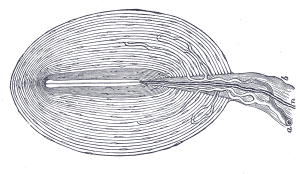
1. What are the somatosenses and the cutaneous senses?
2. How do specificity theory and pattern theory try to explain the perception of touch?
3. What are two neural pathways, and how are the cutaneous senses represented in the cortex?
4. How is tactile information processed? What is the two-point threshold?
5. What is J.J. Gibson’s idea of active touch?
6. How is temperature perceived?
7. How is pain perceived? What is Gate Control Theory?
8. What is synesthesia, and what are two theoretical explanations of it?
The somatosenses are the bodily senses:
• _________ senses: based on mechanoreceptors in the skin
- touch/tactile perception, vibration, texture, shape, warmth, cold, itch, & pain
• ______________: sensing position of the body and limbs
• kinesthesis: sensing movement of the body and limbs
• haptic perception: coordination of tactile and kinesthetic sensation
• vestibular sense (equilibrioception): balance/spatial orientation (semicircular canals and vestibular sacs)
(Note: textbook does not explicitly include vestibular sense as part of the somatosensory system.)
- heaviest organ in human body: weighs 4 kg (8% of body mass)
- on average, 1.8 m2 in area
- thickness ranges from 0.5 mm (____) to 4.0 mm (____)
- may be ________ (non-hairy) or hairy
- outer layer is _________, surface is corneum
- inner layer is ______
- neural structures at the epi-/dermal boundary are believed to be receptors
Specificity Theory (Max von Frey, 1894):
- one mechanoreceptor type proposed for each basic sensation:
• ______: Ruffini endings
• ____: Krause end bulbs
• _____: Meissner corpuscles
• ____: free nerve endings
- complex sensations supposedly comprised of “touch ______”:
• wet: even pressure, cold
• oily: weak pressure, warm, and movement
- ________ (“pointlike”) sensitivity: if there’s a receptor under the skin at a location, there must be sensitivity to the associated sensation
How to determine?
- stimulate skin, record sensation, determine which receptor type is responsible
- ________________: use electrode to find a nerve fibre (axon from receptor) triggered by the stimulus
- _________: trace fibre back to the receptor
Problems:
• slightly problematic for participants
• ____-__________: no correlation between structures and sensations; retest impossible
• skin _________ kinetic and thermal energy over a distance from the point of stimulation--many receptor types affected by any stimulus
• ______ has only free nerve endings, but all four sensations
• sensory spots changed over time (e.g., touch in the morning, cold in the evening)
• _______ _____ illusion: (Thunberg, 1896): holding a grill of interlaced warm (40 °C) and cool (20 °C) bars feels painfully hot
Conclusion: cannot determine which potential receptor structure associated with each sensation.
Pattern Theory (D.C. Sinclair, 1955):
- the pattern of neural impulses from a number of receptors corresponds to a particular sensation
- assumed that receptors differ in structure, but not in ________
- the same receptor can yield two different kinds of sensations, depending on the intensity of activation
e.g., mild pressure → touch; more intense pressure → pain
- but why have so many different kinds of receptors?
________ __________(Melzack & Wall, 1962):
- intermediate approach: each sensation arises from the firing of a number of receptor types, tuned to different aspects of a stimulus
- evidence: Lowenstein & Skalak (1966):
• dissected Pacinian corpuscles (PCs)
• 1-4 mm long; have 20-40 layers

• corpuscle around nerve fibre acts to ______ sustained pressure
• fibre itself only stimulated at onset or offset of stimulus (or by changing stimulus)
- more recent evidence supports stimulus preference of other nerve fibres
• fibres are relatively specialized to certain stimulation, but may also respond (more weakly) to other stimuli:
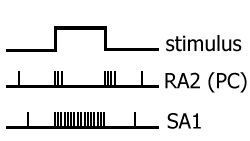
• _____________ pathway
- smaller nerve fibres synapse in the spinal cord
- ascends via spinal cord and brainstem to the thalamus
- projects to the anterior cingulate cortex (involved in pain), insular cortex (involved in emotion), and primary somatosensory cortex
- carries primarily temperature and pain information
• dorsal column-______ _________ pathway
- larger, longer nerve fibres synapse in the _______
- ascends via medial lemniscus to the thalamus
- projects to the primary somatosensory cortex
- conveys touch and proprioceptive information
- research methods:
• ______ potential method:
▸ electrode on scalp measures cortical activity
▸ different skin loci stimulated until activity produced at electrode
▸ very time-consuming
• ___________ (Penfield & Boldrey, 1937):
▸ operating to remove tumours
▸ didn’t want to damage sensorimotor areas
▸ stimulated cortex with low voltage, which produced sensations in awake patients
▸ allowed mapping of sensory and motor cortexes
- cortex has somatotopic organization: adjacent points on the skin have adjoining cortical representations (and columnar organization similar to visual cortex)
- touch represented in somatosensory cortex as a body map, or __________ (“little man”)
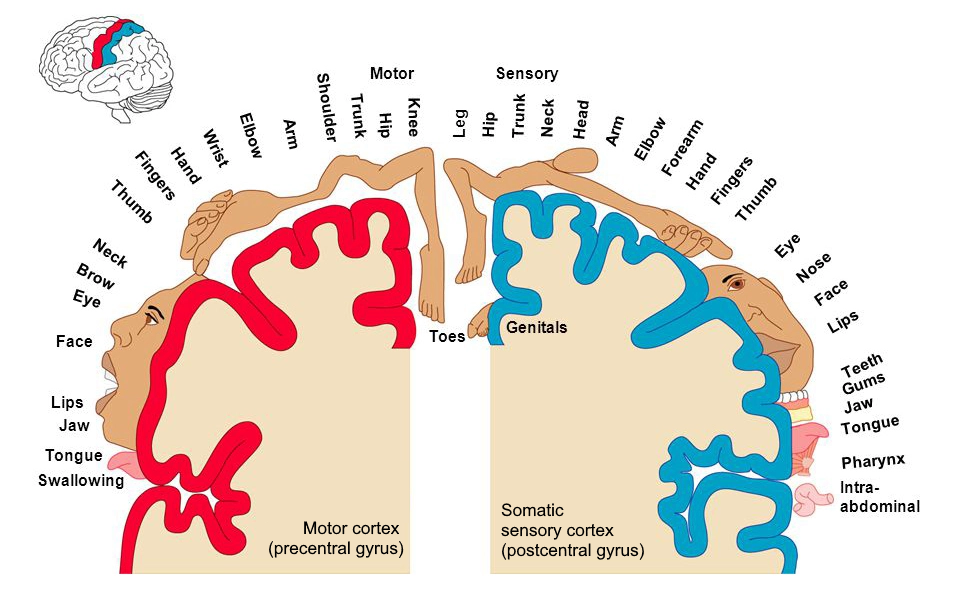
• some parts of homunculus disproportionately _____ compared to corresponding body locus (e.g., lips)
• these body areas are more _________, partly due to increased density of receptors
• amount of cortical area can be changed via experience--even in adults: experience-dependent neural __________
• there are multiple homunculi; each has a different function (e.g., discrimination of forms/shapes, textures, etc.)
• touch is constant pressure; vibration is changing pressure
• stimulus containing kinetic energy causes an abrupt change in skin tension
• soft touch signals go to part of the insular cortex that processes emotion
• plays a major role in development, social cooperation, and affiliation
• may be evolutionary holdover from social grooming--important for maintaining social relationships
Tiffany Field et al. (1986):
- premature babies ________ (vs. in incubator)
- gained 47% more weight
- more socially responsive, slept better
- discharged 6 days earlier (saved $10,000/infant)
Edward T. Hall (1966): zones of personal space (a.k.a. _________):
- distances between people depend on the nature of the social interaction
• public distance: for public speaking (over 3.5 m, 12 ft)
• social distance: for interactions with strangers and acquaintances (1.2-3.5 m, 4-12 ft)
• personal distance: for interactions with friends and family (45-120 cm, 1.5-4 feet)
• intimate distance: for whispering, touching, or embracing intimate partners (15-45 cm, 6-18 inches)
- these distances can vary among cultures
Crusco & Wetzel (1984):
- waitresses at two restaurants in Oxford, Mississippi enlisted to investigate the effects of touch on tipping
- touch manipulations:
a) control condition: no touch
b) placed hand on diner’s ________
c) touched diner’s ____ when giving change
- results:
a) smallest tips
b) 18% greater tips than control
c) 37% greater tips than control
- other findings (Mlodinow, 2012):
• 60% of diners touched by a server took server’s suggestion to order the special (compared to 40% who weren’t touched)
• men who asked women for a date and touched them got 20% acceptance (compared to 10% with no touching)
• touching increases likelihood single women in a nightclub will accept an invitation to _____ by about 20%
• increases the chances a student will go to the blackboard to answer a statistics question by about 20%
• increases compliance in participants filling out a 10-minute survey by about 20%
________: hormone synthesized in the hypothalamus and stored in the pituitary gland
• involved in contractions during labour, and lactation
• also released by touch and at ______ in males and females; may cause endorphin release
Turner et al. (1999):
- oxytocin levels measured in blood samples of 26 women
- relaxation _______: oxytocin levels rose slightly
- recollection of a ________ emotion: oxytocin fell slightly
- recollection of a ________ emotion: no effect
Measuring touch threshold:
• absolute threshold
- von Frey hair pushed into skin until hair bends
- each bends with a different amount of force
- use stronger hairs until absolute threshold established
• difference threshold is called ___-_____ threshold: smallest separation between two points on the skin that can be perceived
• actively handling an object aids identification
J.J. Gibson (1962)
- observers had to identify shape of six cookie cutters, while blindfolded (e.g., teardrop, star, triangle )
- pushed onto palm (passive): __% correct
- actively handed: __% correct
Lederman & Klatzky (1990):
- observers handled objects from 57 different classes
- different “___________ procedures” provide information on different stimulus features:
• lateral motion & contour following: texture
• pressure: hardness
• static contact: temperature
• unsupported holding: weight
• enclosure: global shape, volume
• enclosure & contour following: specific shape
- generality of information from EP _________ related to duration
e.g., enclosure EP (very general) is brief
- related to touchscreen gestures:
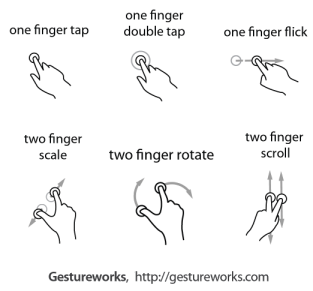
Dallenbach (1927):
- found no correspondence between spots on the skin that responded to both cool and warm
- perception of warmth and cold are ________
Temperature encoded by two types of fibres:
- warm fibres: 30-48 °C
- cold fibres: 20-45 °C
- thermal grill illusion simultaneously activates both warm and cold fibres
- ___________ cold: hot stimulus (45-50 °C) produces sensation of cold; may be due to activation of cold fibres
Thermal adaptation:
- John Locke (1690) found adaptation is local, not global
• fill three bowls with water: one hot, one lukewarm, one cold
• put your left hand in the hot water and your right hand in the cold water until they have adapted
• put both hands in the lukewarm water
• your left hand feels cool, your right hand feels warm
• each hand has adapted to a different temperature
- physiological ____: temperature to which receptors have become adapted; perception of temperature is relative to this point
- only occurs completely within 29-37 °C range (normal skin temperature = 33-35 °C)
- fully takes ~20 min; depends on difference from normal temperature
• pain is “An unpleasant sensory or emotional experience associated with, or resembling that associated with, actual or potential tissue damage” (IASP, 2020)
• nociception is neural encoding of impending or actual tissue damage (i.e., noxious stimulation)
• pain is evolutionarily adaptive:
tissue damage → intense pain → lots of motivation
• once thought to be result of excess of _________, but is more complex than this
• affected by non-physical factors, including ________ background
Specificity theory:
• ___________: receptors for noxious stimuli; peptide substance P released from C fibres
• Aδ fibres transmit sharp, pricking pain
• C fibres transmit burning, throbbing pain
• ______ pain: sharp pain, followed by dull pain
• fibres enter spinal cord via dorsal horn, then to substantia gelatinosa
• evidence: Congenital Insensitivity to Pain with Anhidrosis (CIPA)
- extremely rare genetically recessive disorder; incidence: 1 in 125 million
- symptoms include slow mental development, lack of sweating, impaired temperature sense; are prone to burns
- __% die of hyperpyrexia (fever) in first 3 years of life
- poor prognosis: most do not live past age 25
- complete absence of Aδ and C fibers; normal sensation of touch in Aβ fibres
(Ronald Melzack & Patrick Wall, 1965; 1988):
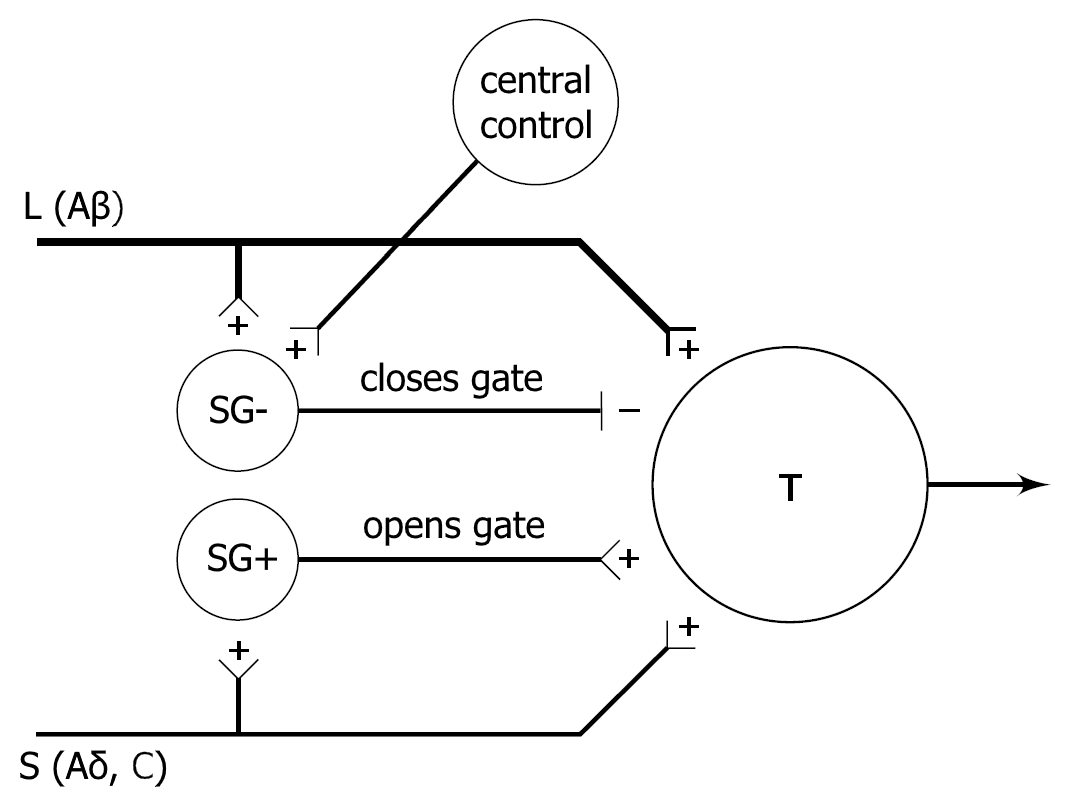
• SG is substantia gelatinosa (in spinal cord)
• T is pain transmission cell (in spinothalamic pathway)
• L-fibres are large diameter axons from mechanoreceptors
• S-fibres are small diameter axons from nociceptors
• central control is top-down signals from the brain
• activity in L-fibres: ______ gate
- activates SG- → T-cell inhibited: no pain signal
• activity in S-fibres: _____ gate
- activates SG+ → T-cell excited: pain signal sent
• rubbing may reduce pain by activating Aβ fibres
• Shealy et al. (1967): TENS
- Transcutaneous Electrical Nerve Stimulation
- small electrical current at 70 Hz activates Aβ fibres
- inhibits pain signals
• central control may also shut the gate:
▸ _______ effect: person led to believe that a substance will relieve symptoms, feels no pain
e.g., Kosambi (1967):
- charak puja or hook-swinging festival of parts of India
- steel hooks inserted under ____ _______ of chosen man
- suspended from ropes attached to a cart
- pushed from village to village to bless children & crops
- no evidence of pain, but in a “state of exultation”
How are the pain signals attenuated?
• may be due to endogenous opioids: natural analgesics in the brain
e.g., __________ (pituitary) and ___________ (CNS, intestines)
• inhibit substance P
• evidence: naloxone (Narcan®)
- narcotic __________ (blocks opioids)
- _____ ___ effects of placebo and acupuncture, but not hypnosis
• from Greek syn (together) + aisthesis (to perceive)
• involuntary experience of a _____-_____ association, in which stimulation of one sensory modality reliably causes an experience in another, different modality
e.g., a voice is not only heard but may be felt, seen, or tasted
the stimulus that triggers the synesthesia is the inducer, and the modality in which the resulting synesthesia is experienced is the concurrent (inducer → concurrent)
e.g., spoken word → colour
• not the same as using a metaphor to describe an experience
e.g., calling high-pitched sounds “bright”
• studied in late 19th century; ignored until research review by Larry Marks (1975)
• incidence: 1 in 23; self-disclosure more likely in women
Characteristics:
• responses are _______ and unelaborated
e.g., colours, simple shapes, textures, tastes
• ___-___ projections: a spoken word → colour synesthete does not hear words when viewing colours
• _____________: different synesthetes: different experiences to same stimulus
Theories:
• more ___________ (Ramachandran & Hubbard, 2001)
- synesthetes have genetic overabundance of neural ___________
- increased wiring is due to insufficient pruning
- this results in a breakdown in the modularity of perception, so that one modality “_______” an event in another
- evidence: synesthetes found to have greater neural connectivity
• less __________ (Grossenbacher & Lovelace, 2001)
- not due to abnormal connections
- normally, excitation and inhibition in the brain are balanced
- in synesthetes, there is less inhibition in feed-backward connections from high-level ____________ brain areas to single-sense areas
- evidence: synesthesia-like experience may be induced in anyone by ___ or mescaline, which may activate existing pathways
Research:
• Baron-Cohen et al. (1993): test of genuineness
- spoken word → colour synesthetes and nonsynesthetes described colours evoked by 100 words
- consistency of nonsynesthetes after 2 weeks: 20%
- consistency of synesthetes after 1 ____: 92.3%
• Nunn et al. (2002):
- fMRI scans of 12 female spoken word → colour synesthetes
- response to words in auditory and language areas same as controls
- spoken words:
• activated left __, but not V1 or V2
• activated episodic memory/_______ areas
- viewing coloured surfaces, left V4 not activated (“________” by synesthesia?)
- parallels the finding that nonsynesthetes imagining colours do not activate __
- thus, synesthetic colour experience is consistent with colour __________, as opposed to colour imagery
Implications:
• synesthesia may reveal aspects of ___-____ processing, the binding problem, sensory integration, and _________ experience